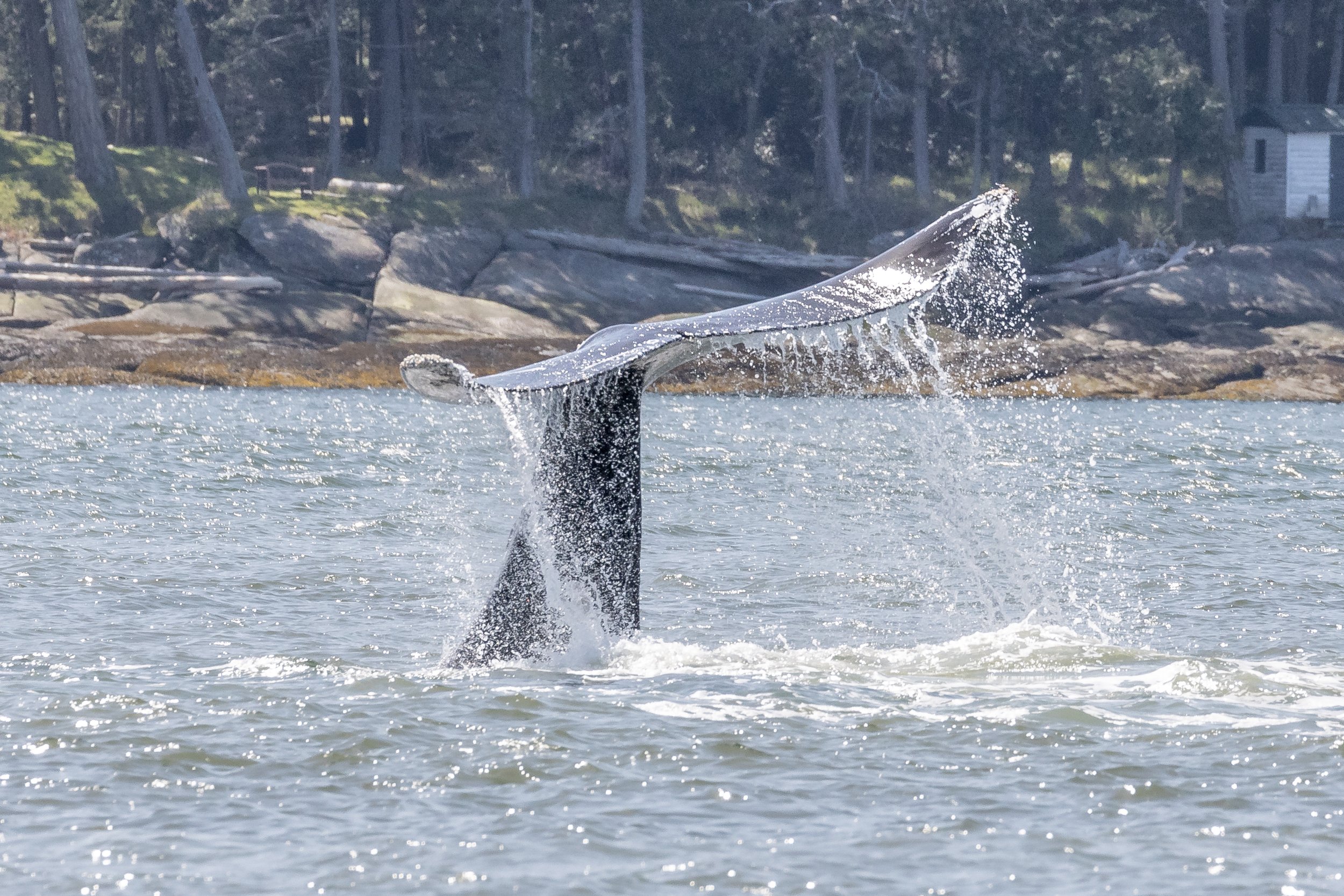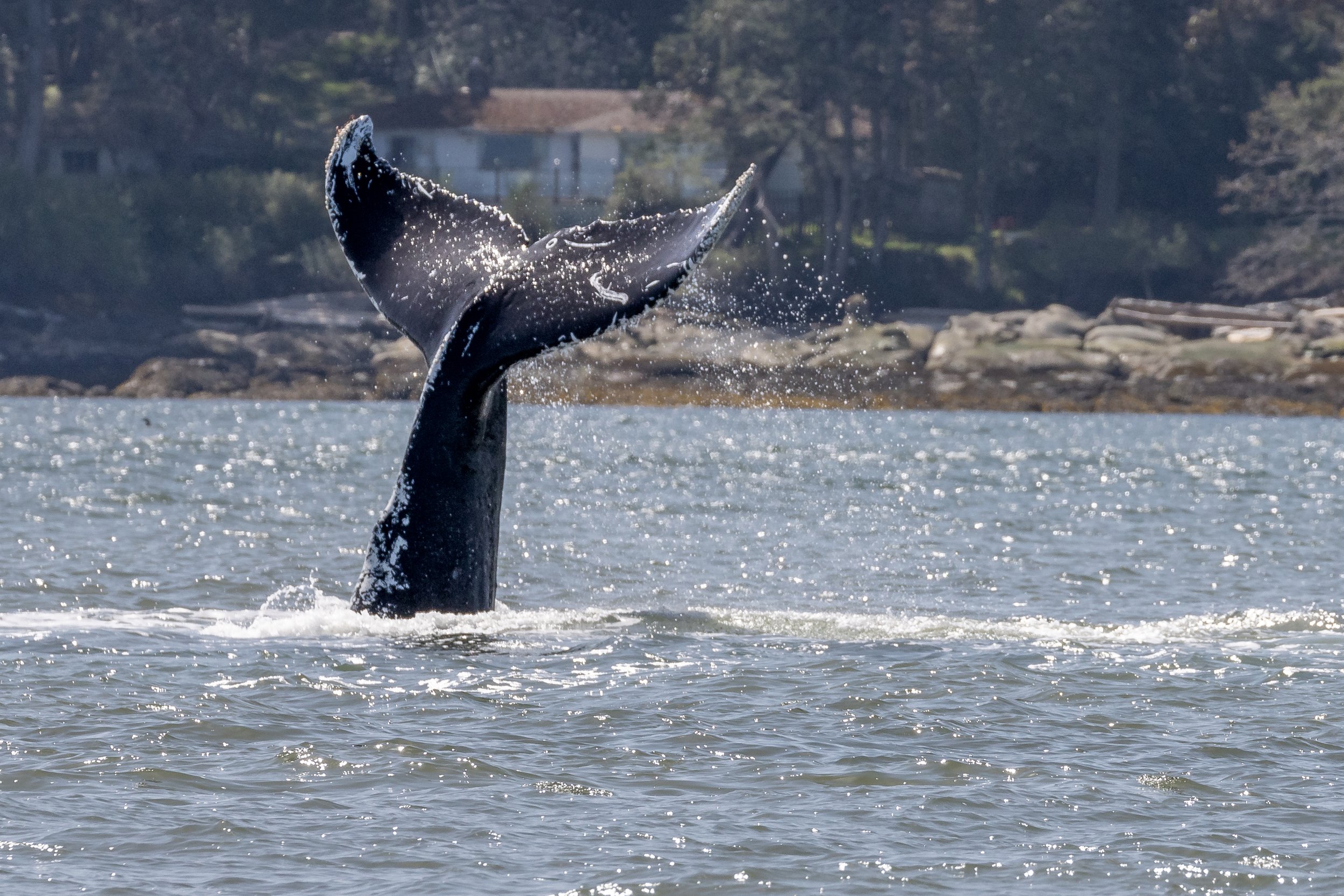April 28, 2023 - First Humpback of the Season!
While we love going out on adventures no matter the time of year, the first time we encounter a Humpback in the season is always extra exciting! These gentle giants are beginning to trickle their way back into our area after completing their migration from their breeding grounds in Hawaii and/or Mexico. They are quite tired when they arrive in our waters as they rely on their fat deposits to keep them fed during their migration. Much to our surprise, today’s Humpback seemed to be full of energy. This could suggest she is already quite well-fed. This is a great sign considering how early we are into the year - there is likely a lot of food around! Humpbacks have a varied diet including krill, zooplankton, phytoplankton, herring, juvenile salmon, pollock, and small crustaceans.
Humpback whales were once hunted to near extinction, but thanks to conservation efforts, their populations have rebounded. They are now considered a conservational success case. When you consider the huge range Humpbacks travel in, this is no small feat. Many measures have been put in place to help their numbers recover including the banning of whaling in most countries, the restriction of fisheries, shore-based and water-based cleanup efforts, and population monitoring by marine biologists in their feeding grounds, their breeding grounds, and along their migration route’s shorelines.
Today’s Humpback was an extra special surprise - we have never encountered this individual before! SEAK-UASE-HEV-20040715-1-016 also known as SPLASH-474404 is usually seen in Southeast Alaska, so she is still quite far away from her regular feeding grounds. First seen in 2004 during the SPLASH project, she is at least 19 years old. Typically we do not know if a Humpback is male or female unless they bring a calf back with them, however, this whale is a special case! The University of Oregon’s Cetacean Conservation and Genomics Laboratory was able to confirm her sex by genetic testing during the SPLASH project.
Usually, we ID Humpbacks by the underside of their flukes (tails). There are many catalogues you can reference to do this, including the Keta Coastal Conservation Catalogue. Today’s individual, however, was stumping us. This female Humpback has quite a few identifiable markings including a variety of scratches and one large circular scar near the middle. Theoretically, she should be fairly easy to ID! However, we weren’t able to locate her in any of our local catalogues. After much searching and cross-referencing with Happy Whale, we found her in the Humpback Whales of Southeast Alaska (SEAK) Catalogue (page 276)!
Her codes are not very easy to remember, so we hope this big girl gets her own nickname soon! If you could name this humpback, what would you call her? Humpback nicknames generally relate to the pattern on their fluke in some way.
She also unique scarring on both sides of her dorsal fin. We aren’t always able to get a nice clear fluke photo when on scene with whales, so it’s extra handy to take photos of dorsals too as they may be the only way we can ID an individual.
While the SEAK Catalogue is one of our less commonly used ID guides, we have had to reference it a handful of times in the past years due to a new young whale appearing in our area. Squirrel (also known as Smoke or Scorch), was first spotted in our area in the Spring of 2021. Unfortunately, Squirrel experienced a traumatic event sometime between July 9, 2021 and August 6, 2021, seriously damaging their fluke. They healed up well but their fluke was permanently changed - they now had a large starburst pattern on one side and a large gash on the other.
While these changes made it difficult to determine whether these two encounters were with the same whale, Squirrel does have a small circular scar on the bottom of his left fluke that was visible both pre and post-injury as well as a few small scratches that we were able to use for ID reference points. Can you spot these markings in the series of photos below?
Pre-injury, July 9 2021
Fresh Injury, August 24 2021
Post-injury, May 25 2022
Squirrel seems to have taken a liking to our area as they have returned to our area repeatedly in the past few years. In the Winter of 2021 we were able to cross reference Squirrel on Happywhale and were excited to find out his mother Flame (SEAK-1538, page 11 in the catalogue) was a well-known Alaskan whale!
After our adventures with our lovely humpback, we headed out in search of other wildlife. Today we were able to spot a bob of seals curiously watching us on the rocks, some sleepy sea lions on the log booms in Northumberland channel, and a variety of gulls paddling along in the waters of the Southern Gulf Islands.
Please enjoy today’s photos taken by Marine Naturalist Desarae (Des) Poier.
SEAK-UASE-HEV-20040715-1-016 has quite a few distinct markings on her fluke which help to confirm her ID!


































